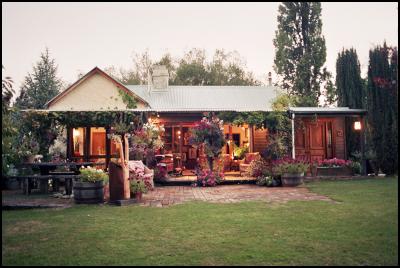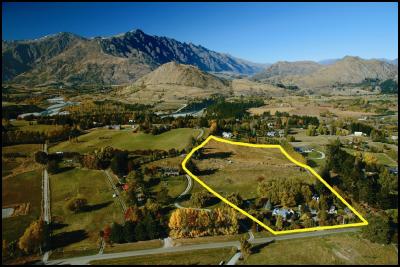Historic property near Queenstown - many options
Historic property near Queenstown offers multiple options

Click to enlarge

Click to enlarge
MEDIA RELEASE
Historic property near Queenstown offers multiple options
11 February 2008: A unique historic property near Queenstown, one of the last remaining original 1800s homes in the area, is on the market for the first time in more than 30 years with multiple options available to future owners.
Being marketed by Fraser Skinner and Muffy Marsden of Harcourts Arrowtown, the 3.17 hectare (8 acre) property at Dalefield, between Arrowtown and Queenstown, was chosen in the 1870s by the original Dalefield farmers as the perfect location for their home, Pear Tree Cottage.
Today a two-bedroom home in use as an internationally renowned self-contained home-stay, Pear Tree Cottage started life as a small three room cottage - believed to have been moved from Skippers Canyon onto the Wakatipu Basin property in the 1870s. Set in extensive, sheltered gardens and with gorgeous mountain and rural views the cottage, which has been modified over the years, was in bad shape when the current owners purchased it in 1976.
“They ignored advice to bulldoze it and instead lovingly restored it over the years, reusing original materials or recycled products from near by where possible,” Ms Marsden says. “For example they’ve reused old roofing iron on interior walls, papered one wall with early ‘Otago Witness’ newspapers found in the walls and used old handmade bricks from Queenstown for some internal walls.”
Currently being used as exclusive private holiday accommodation, Pear Tree Cottage has two double bedrooms, a separate lounge with a large open fire, a new bathroom, a large open plan “farmhouse-style” kitchen/dining room, a bar area and an extensive sun-drenched deck.
Also nestled nearby on the rural property is a fully self-contained one bedroom cottage, used by the current owners as their home. There are also numerous other outbuildings providing plenty of options for storage, office space a workshop or studio.
Ms Marsden says this property offers plenty of options. “It could be bought as a going concern; either or both of the existing residences could be added to create a larger family home and/or to provide additional room for paying guests or a business and there are other possible development opportunities too.”
Just a short drive to Coronet Peak
and a few minutes to Queenstown this unique property is for
sale for $2.1 million. To find out more: visit
www.harcourts.co.nz (ID: AW071202) or visit
www.peartree.co.nz
Please see the attached Word
document prepared by the owners on the property’s history,
plus the attached photos.
For further comment contact: Kelvin Collins, Business Owner of Harcourts Arrowtown and Queenstown
ENDS
Pear Tree Cottage
A brief history
Pear Tree Cottage started life in the early
1870's when a small three bedroom cottage was (probably)
moved onto the present site as a farm house for what was to
become known as "Dalefield" farm. The earliest land title
was registered in October 1872 under the names of George
Mico Ross and James William Robertson. The area was then
registered as 195 acres, three roods and 15 poles, being
“more or less situated in the Shotover Survey District
being sections numbered respectively 8, 15, 18, 74 and
76”.
A Certificate of Title dated the 23rd of July 1880 from George Ludermann to John Healy and Michael Moran indicates the Property had considerably increased in size by this time, being detailed as 325 acres, 1 rood and 38poles.
It is interesting to note that what is now known as Dalefield Road was originally known as Thurlby Road and in fact was still designated as Thurlby Road when the property was purchased by Reid Developments Ltd in September 1972. The writer assumes that the name of the road was changed subsequent to that, when Reid Developments sub-divided “Dalefield Farm” into 10 acre lots.
A mortgage transfer dated 18th of August 1919 indicates that Elizabeth McLean and Archibald Fotheringham Hawke purchased the property about that date. Elizabeth McLean and then her son Bill McLean (died 1971) and his wife Annie – nee Brown - (died 1989) lived in the cottage and farmed the area up to 1955 at which date it was sold to Lyall Coombes. Annie McLean (Brown) was born and brought up on Islay Farm at Lower Shotover. Islay was sold to the Dennison family about 1960-63. Their children are Neil and Faye who spent their childhood on the property.
Dalefield Farm occupied the area (approximately) bounded to the east by what is now know as Dalefield Road, to the west by the gully that runs at right angles at the end of Mountain View Road (this road was not in existence before Reid Developments purchase of the farm in 1972), to the south by Littles Road and to the north by the hill that lies to the north of Mountain View Road. The word “Dalefield” was spelled out in daffodils on the rise behind the house. The Real Estate industry seems determined to now call almost all of the Wakatipu Basin “Dalefield”, but in fact the area described above is the only area with any rightful claim to this name. In this writers opinion it is a tragedy that, because of this practice, the wonderful old names of the district – Lower Shotover, Speargrass Flat, Slope Hill, Wharehuranui and many others – are being lost.
The original small three room cottage originally moved onto the site is that area of the house that now contains the two bedrooms. The archivist at the Arrowtown Museum in 1997, Julia Bradshaw, was unable to identify the date the original cottage appeared on the property but expressed the opinion that it was very probably shifted from Skippers in the early to mid 1870’s. Amazingly, apparently many miners’ cottages were moved from Skippers to the Wakatipu Basin in the latter part of the 19th century. Each subsequent owner has added onto that structure to expand the house into what had, by the 1950's, become a relatively comfortable but quite small typical New Zealand farmhouse of that era.
The old hut still standing outside the back door of the house was the “Dairy Hut”. The barn is only one left of two original barns. Bill McLean engaged Jock Boyd to add the kitchen and veranda to the house about 1948. In 1951 the McLean family were still using kerosene lamps as their only form of lighting and a coal range (not taken out until 1982) as their only method of cooking. Bill McLean used an eight horse team up to 1951, at which time he purchased a Bristol 20 tractor and the next year he purchased a Caterpillar D2
In 1972 a property development company, Reid Development Co, purchased Dalefield Farm from Ian Faulks and subdivided the land into ten acre lots. From that date Dalefield Farm became known as just "Dalefield".
In 1976 the present owners, Terry and Erina McLean, retailers in Queenstown at the time, purchased the property which by this time had become very run down and in fact almost derelict. It seems destined that the McLean's were meant to live here as they trace their ancestry back to the same Highland Scottish Clan as the McLean's who owned the property for almost half of the last century – McLean of Duart
When we - Terry and Erina McLean - moved into the cottage something had to be done immediately to make it habitable as the floor had large holes where the floor boards had rotted out and the roof was coming off. To raise funds for improvements a valuer was approached and his advice was "have you thought of a bulldozer?” Fortunately his advice was ignored and over the following twenty three years the cottage was gradually restored. Most of the materials used are from demolition sites and in fact much of the wall linings consist of materials actually taken from the original structure of the cottage. The walls of one bedroom and the laundry are lined with the old roofing iron and one wall is papered with early "Otago Witness" newspapers dated 1900 to 1903 found inside the walls during renovations. Internal brick walls have been built from old hand made Queenstown bricks


 University of Canterbury: Research Sheds Light On Fire Risk For Canterbury
University of Canterbury: Research Sheds Light On Fire Risk For Canterbury GE Free NZ: Potential $20 Billion Loss In Export Demand Threatens Rural Communities
GE Free NZ: Potential $20 Billion Loss In Export Demand Threatens Rural Communities Science Media Centre: Carbon-storing Construction Materials – Expert Reaction
Science Media Centre: Carbon-storing Construction Materials – Expert Reaction Vegetables New Zealand: New Web-Based Tool Will Help Greenhouse Growers Switch To Geothermal Heating
Vegetables New Zealand: New Web-Based Tool Will Help Greenhouse Growers Switch To Geothermal Heating Horizon Research Limited: New Poll - New Zealanders Prefer Rail Enabled Ferries
Horizon Research Limited: New Poll - New Zealanders Prefer Rail Enabled Ferries Watercare: Watercare Gets To Work On First Permanent Non-Potable Water Tanker Filling Station In Māngere
Watercare: Watercare Gets To Work On First Permanent Non-Potable Water Tanker Filling Station In Māngere



